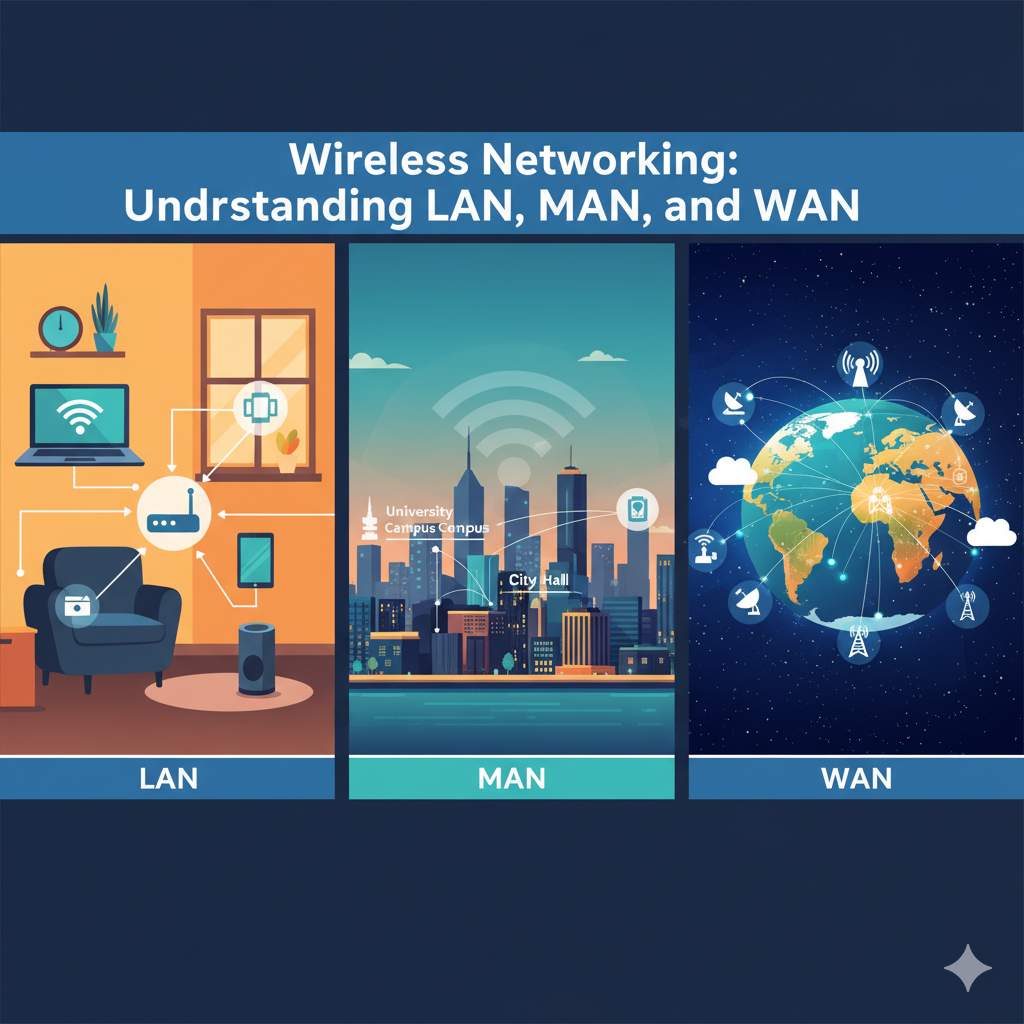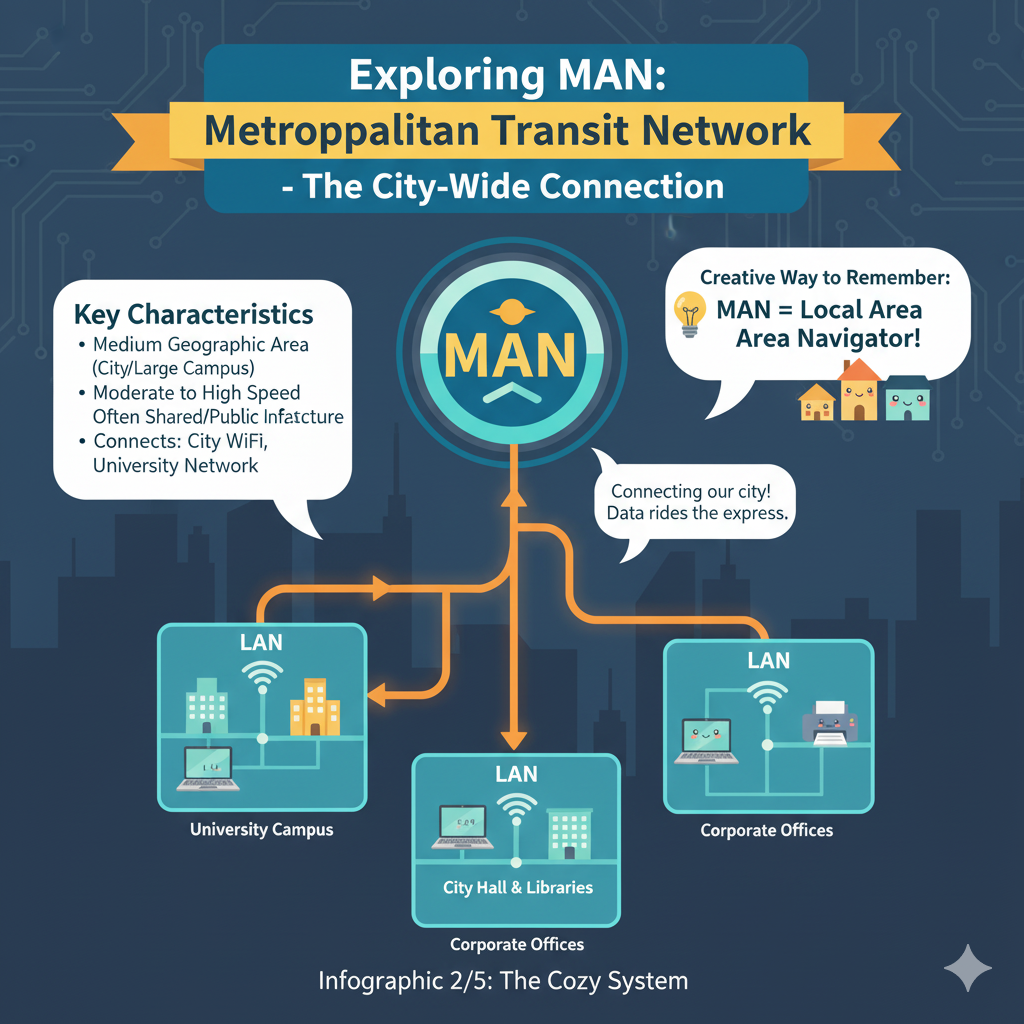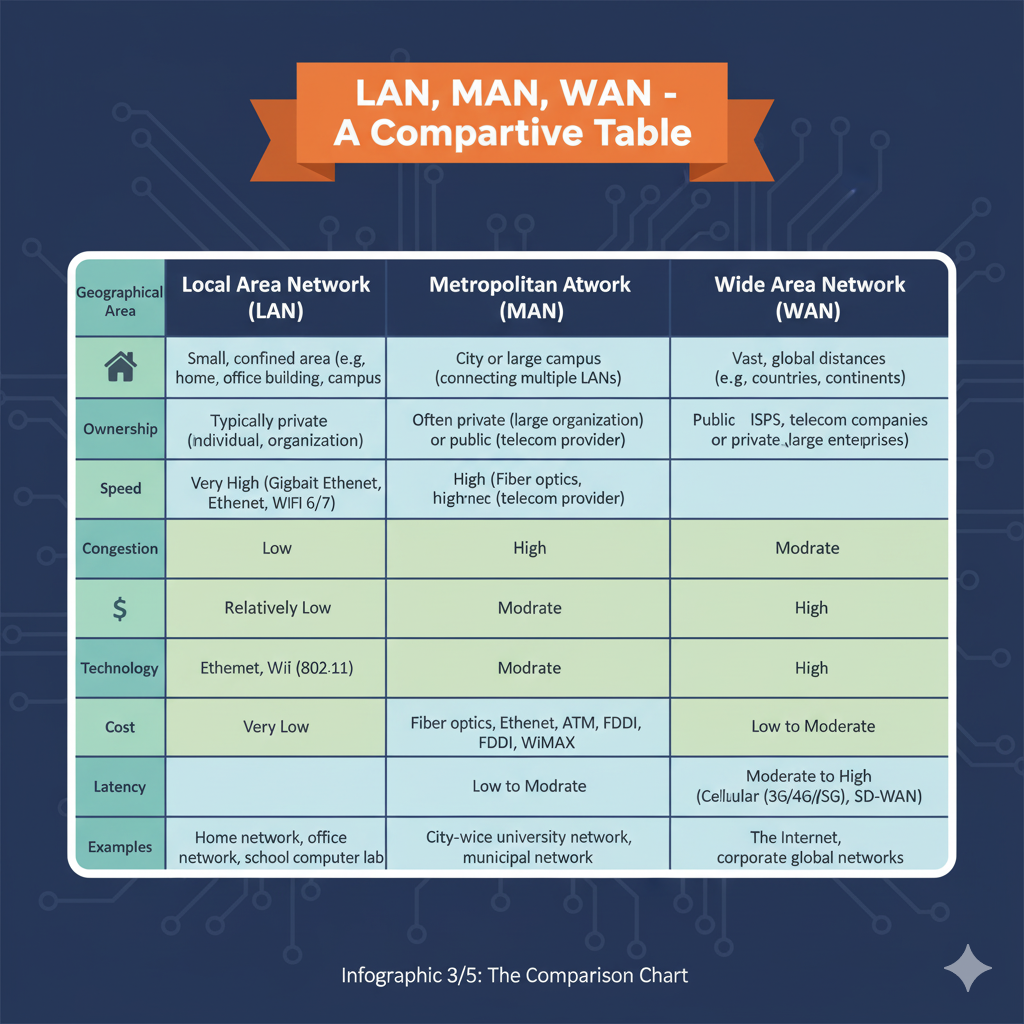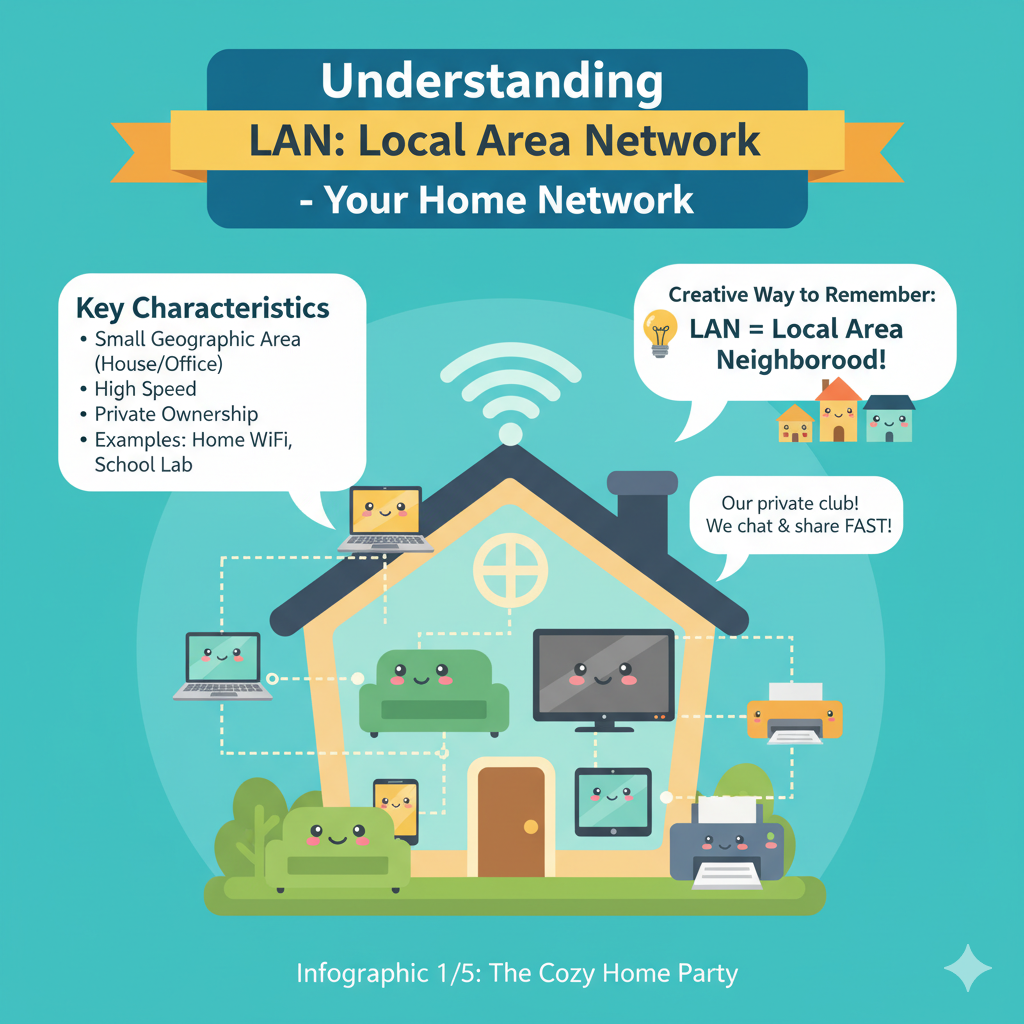
In today’s interconnected world, wireless networking has become an indispensable part of our daily lives.
From streaming our favorite shows at home to conducting global business meetings,
the ability to connect without physical cables has revolutionized how we interact with information and each other.
But have you ever stopped to think about the different types of networks that make this seamless connectivity possible? It’s more nuanced than just
just a simple Wi-Fi connection.
There are distinct categories of networks, each designed for different scales and purposes.
Today, we’re going to dive deep into three fundamental types:
Local Area Networks (LAN), Metropolitan Area Networks (MAN),
and Wide Area Networks (WAN).
Understanding their differences is key to grasping the backbone of our digital existence.

Videos are added as random thoughts 💭 💭 💭
What is a Local Area Network (LAN)?
Let’s start with the most familiar one: the Local Area Network, or LAN. Think of a LAN as your personal digital playground.
It’s a network that connects computers and other devices within a relatively small, localized area.
This could be your home, an office building, a school, or even a small campus [1].
The primary characteristic of a LAN is its limited geographical scope.
Because of this, LANs typically offer very high data transfer rates,
allowing devices to communicate with each other quickly and efficiently.
Imagine sharing files between computers in your office or playing online games with friends in the same house – that’s a LAN in action.
In a home setting, your Wi-Fi router is the heart of your wireless LAN (WLAN).
It broadcasts a signal that your laptop, smartphone, smart TV, and other devices can connect to.
This allows them to access the internet and communicate with each other.
In an office, a LAN might involve a combination of wired Ethernet connections and wireless access points, all managed to provide seamless connectivity for employees.
The beauty of a LAN lies in its speed and security; since it’s confined to a small area, it’s generally easier to manage and protect from external threats.
LANs are often privately owned and managed.
This means that the organization or individual using the LAN is responsible for its setup, maintenance, and security.
This control allows for customization and optimization tailored to specific needs.
For instance, a small business might configure its LAN to prioritize certain types of traffic, like voice over IP (VoIP) calls, to ensure clear communication.
The technologies commonly used in LANs include Ethernet for wired connections and Wi-Fi (IEEE 802.11 standards) for wireless connections.
These technologies enable devices to share resources like printers, servers, and, most importantly, a single internet connection.
The high bandwidth and low latency of LANs make them ideal for applications that require quick data exchange, such as real-time collaboration tools and database access.
Without LANs, our modern homes and workplaces simply wouldn’t function as efficiently as they do today.
What is a Metropolitan Area Network (MAN)?
Moving up in scale, we encounter the Metropolitan Area Network, or MAN.
As the name suggests, a MAN is designed to cover a larger geographical area than a LAN, typically spanning a city or a large campus [1].
Think of it as a network that connects multiple LANs within a metropolitan region.
For example, a large corporation with several branch offices across a city might use a MAN to connect all its locations, allowing them to share resources and communicate as if they were in the same building.
Universities with multiple campuses spread throughout a city also frequently utilize MANs to link their various departments and facilities.
The key characteristic of a MAN is its intermediate size.
It’s larger than a LAN but smaller than a Wide Area Network (WAN).
MANs often use high-speed connections, such as fiber optics, to ensure efficient data transfer between the connected LANs.
While a LAN is usually privately owned, a MAN can be owned and operated by a single organization, or it can be a public network provided by a telecommunications company.
This dual nature allows for flexibility in how MANs are implemented and managed.
For instance, a city government might establish a MAN to connect all its municipal buildings, police stations, and libraries, creating a unified communication infrastructure.
One of the primary advantages of a MAN is its ability to provide shared access to resources and services across a city.
This can include centralized servers, data centers, and even internet gateways.
By connecting multiple LANs, a MAN facilitates efficient data exchange and collaboration among different sites.
For businesses, this means employees in different offices can seamlessly access the same applications and data, improving productivity and streamlining operations.
For residents, a public MAN might offer city-wide Wi-Fi access or support smart city initiatives like intelligent traffic management systems and public safety surveillance.
The technologies underpinning MANs often include Ethernet, ATM (Asynchronous Transfer Mode),
and FDDI (Fiber Distributed Data Interface), with fiber optics being a common transmission medium due to its high bandwidth capabilities.
The implementation of wireless MANs is also growing,
utilizing technologies like WiMAX (Worldwide Interoperability for Microwave Access) to provide broad coverage across urban areas.
MANs play a crucial role in bridging the gap between localized networks and global connectivity, forming an essential layer in the overall networking hierarchy.
https://youtu.be/1TDZVhlELo4?si=Dad21he1XUl5CsD4
What is a Wide Area Network (WAN)?
At the broadest level of network classification, we find the Wide Area Network, or WAN. A WAN is truly a global connector, designed to span vast geographical distances, often connecting cities, states, countries, or even continents [1].
The internet itself is the most prominent example of a WAN, connecting billions of devices and networks worldwide.
Unlike LANs and MANs, which typically cover a limited area, WANs are built to facilitate communication and data exchange over long-haul connections.
This expansive reach is crucial for businesses with international operations, allowing them to link their various branches and data centers across the globe.
WANs are characterized by their ability to connect disparate LANs and MANs, forming a cohesive and interconnected global infrastructure.
Because of the immense distances involved, WANs often rely on a variety of technologies, including fiber optic cables laid across oceans, satellite 📡 📡 links, and cellular networks.
These technologies enable data to travel efficiently across continents, making global communication and collaboration possible.
The ownership and management of WANs are typically more complex than LANs or MANs. Large telecommunications companies, internet service providers (ISPs), and even governments often own and operate significant portions of the WAN infrastructure.
Businesses and individuals then subscribe to services provided by these entities to access the WAN.
One of the primary challenges of WANs is maintaining high data transfer speeds and low latency over long distances.
While a LAN might offer gigabit speeds, a WAN connection, especially over very long distances, might have lower speeds and higher latency due to the physical limitations of signal transmission.
However, continuous advancements in technology, such as faster fiber optics and more efficient routing protocols, are constantly improving WAN performance.
Security is another critical aspect of WANs.
Given their vast and often public nature, securing data transmitted across a WAN requires robust encryption and advanced security protocols to protect against cyber threats.
Virtual Private Networks (VPNs) are commonly used over WANs to create secure, encrypted tunnels for data transmission, ensuring privacy and integrity.
WANs are indispensable for modern global commerce, education, and social interaction.
They enable cloud computing, allowing users to access applications and data hosted in remote data centers.
They support global supply chains, connecting manufacturers, distributors, and retailers worldwide.
Furthermore, WANs facilitate remote work, distance learning, and international communication, breaking down geographical barriers and fostering a more connected world.
Technologies like MPLS (Multiprotocol Label Switching), SD-WAN (Software-Defined Wide Area Networking), and various cellular technologies (3G, 4G, 5G) are pivotal in building and optimizing modern WANs.
Without the robust and far-reaching capabilities of WANs, our vision of a truly global digital society would remain just a dream.
Key Differences and Comparisons: LAN vs. MAN vs. WAN
Now that we’ve explored each network type individually, let’s put them side-by-side to clearly understand their distinctions.
The differences primarily revolve around geographical coverage, ownership, speed, and the technologies employed.
Understanding these variations is crucial for designing and implementing effective network solutions, whether for a small home office or a multinational corporation.
Geographical Coverage: This is perhaps the most obvious differentiator.
A LAN is restricted to a small physical space, offering localized connectivity.
A MAN expands this to cover an entire city or a significant urban area, acting as an intermediary.
A WAN, on the other hand, knows virtually no bounds, stretching across vast distances to connect geographically dispersed locations.
This scaling of coverage directly impacts the complexity and cost of network deployment and management.
Ownership and Management: LANs are almost always privately owned and managed, giving the owner complete control over the network infrastructure and security policies.
MANs can be private, especially for large organizations, or public, provided by service providers.
WANs are predominantly owned and operated by large telecommunications companies and Internet Service Providers (ISPs),
with organizations and individuals subscribing to their services.
This difference in ownership also dictates the level of control and customization available to the end-user.
Speed and Latency: Generally, the smaller the network, the higher the speed and lower the latency.
LANs boast the highest speeds and lowest latency due to their short distances and dedicated bandwidth.
MANs offer high speeds but might experience slightly higher latency than LANs due to the increased distances.
WANs, covering the largest distances, typically have the lowest speeds and highest latency among the three, although advancements in fiber optic technology and routing protocols are continually improving performance.
The speed and latency characteristics are critical considerations for applications that require real-time data processing or high bandwidth, such as video conferencing or large data transfers.
Cost: The cost of implementing and maintaining these networks also scales with their size and complexity.
LANs are the most economical to set up, requiring relatively inexpensive hardware like routers, switches, and access points.
MANs involve a more significant investment due to the need for higher-capacity infrastructure and potentially leased lines.
WANs are by far the most expensive, involving substantial investments in long-haul cabling, satellite infrastructure, and complex routing equipment, often requiring ongoing subscription fees to service providers.
Technologies Used: Each network type leverages specific technologies optimized for its scale.
Ethernet and Wi-Fi are the workhorses of LANs.
MANs often utilize fiber optics and technologies like ATM or FDDI to connect multiple LANs efficiently.
WANs employ a diverse range of technologies, including advanced fiber optic networks, satellite communication, and cellular technologies, along with sophisticated routing protocols like MPLS and SD-WAN to manage traffic across vast distances.
The choice of technology is driven by the need to balance performance, cost, and geographical reach.
Understanding these distinctions helps in appreciating the intricate design behind our global digital infrastructure.
Each network type plays a vital, complementary role in ensuring that data can flow seamlessly from your personal device to a server halfway across the world.
The evolution of these networks continues, driven by the ever-increasing demand for faster, more reliable, and more ubiquitous connectivity.

Wireless Aspects of LAN, MAN, and WAN
While the core definitions of LAN, MAN, and WAN often refer to their geographical scope, it’s important to specifically address their wireless implementations.
Wireless technology has permeated all levels of networking, offering flexibility and mobility that traditional wired connections cannot.
Understanding how wireless capabilities integrate into each network type provides a more complete picture of modern connectivity.
Wireless Local Area Network (WLAN): This is perhaps the most common wireless network we interact with daily.
A WLAN is essentially a LAN that uses wireless communication technology, primarily Wi-Fi (based on the IEEE 802.11 standards), to connect devices.
Instead of Ethernet cables, devices communicate with an access point (AP) or a wireless router, which then connects to the wider network or the internet.
WLANs offer immense convenience, allowing users to move freely within a defined area while maintaining network access.
In homes, WLANs are ubiquitous, connecting everything from laptops and smartphones to smart home devices.
In corporate environments, WLANs provide flexible workspaces, enabling employees to collaborate from various locations within an office building.
The speed and reliability of WLANs have significantly improved with advancements like Wi-Fi 6 (802.11ax)
and the upcoming Wi-Fi 7, offering multi-gigabit speeds and better performance in crowded environments.
Security in WLANs is paramount, with encryption protocols like WPA2 and WPA3 protecting data transmitted over the airwaves.
Wireless Metropolitan Area Network (WMAN):
The concept of a MAN also extends to wireless implementations, forming a Wireless Metropolitan Area Network (WMAN).
WMANs are designed to provide wireless connectivity across an entire city or a large urban area.
One of the most prominent technologies associated with WMANs is WiMAX (Worldwide Interoperability for Microwave Access), based on the IEEE 802.16 standard.
WiMAX was envisioned to provide broadband internet access over large distances,
offering an alternative to DSL and cable for areas where wired infrastructure was lacking or too expensive to deploy.

While WiMAX didn’t achieve the widespread adoption initially predicted, the underlying principle of providing city-wide wireless access remains relevant.
Today, modern WMANs might leverage a combination of technologies, including high-capacity mesh networks, dedicated microwave links,
and even advanced cellular technologies (like 5G fixed wireless access) to connect various points within a metropolitan area.
These networks can support smart city initiatives, public safety communications, and provide internet access to underserved communities, demonstrating the potential for broad-scale wireless connectivity.
Wireless Wide Area Network (WWAN): When we talk about wireless connectivity over vast geographical areas, we are typically referring to Wireless Wide Area Networks (WWANs).
The most common examples of WWANs are cellular networks (3G, 4G LTE, and 5G) and satellite internet.
Cellular networks allow our mobile phones and other cellular-enabled devices to stay connected to the internet and communicate across entire countries and even globally, as long as there is cell tower coverage.
These networks are managed by mobile network operators and provide ubiquitous access for mobile users.
Satellite internet, on the other hand, uses satellites in Earth’s orbit to provide internet access to remote or rural areas where terrestrial infrastructure is unavailable.
While often characterized by higher latency due to the distance signals must travel to space and back, satellite internet is a critical WWAN solution for global connectivity.
The evolution of 5G technology is particularly transformative for WWANs, promising not only faster speeds and lower latency but also massive connectivity for IoT devices,
enabling new applications in areas like autonomous vehicles, remote surgery, and smart agriculture across wide regions.
WWANs are fundamental to our mobile-first world, ensuring that we remain connected almost anywhere we go.
In essence, the essence, the wireless dimension adds another layer of complexity and capability to LANs, MANs, and WANs.
It enhances mobility, extends reach, and enables new applications that were once unimaginable.
From the convenience of your home Wi-Fi to the global reach of 5G, wireless technologies are continually evolving, shaping how we connect and interact with the digital world.
Conclusion
Our journey through Local Area Networks (LANs), Metropolitan Area Networks (MANs),
and Wide Area Networks (WANs) reveals the intricate and layered architecture that underpins our modern digital landscape.
Each network type, with its distinct characteristics in terms of geographical coverage, ownership, speed, and technology, plays a crucial and complementary.
